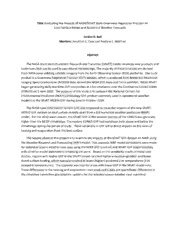
NASA Technical Reports Server (NTRS) 20120016447: Evaluating the Impacts of NASA/SPoRT Daily Greenness Vegetation Fraction on Land Surface Model and Numerical Weather Forecasts PDF
Preview NASA Technical Reports Server (NTRS) 20120016447: Evaluating the Impacts of NASA/SPoRT Daily Greenness Vegetation Fraction on Land Surface Model and Numerical Weather Forecasts
Title: Evaluating the Impacts of NASA/SPoRT Daily Greenness Vegetation Fraction on Land Surface Model and Numerical Weather Forecasts Jordan R. Bell Mentors: Jonathan L. Case and Andrew L. Molthan Abstract The NASA Short-term Prediction Research and Transition (SPoRT) Center develops new products and techniques that can be used in operational meteorology. The majority of these products are derived from NASA polar-orbiting satellite imagery from the Earth Observing System (EOS) platforms. One such product is a Greenness Vegetation Fraction (GVF) dataset, which is produced from Moderate Resolution Imaging Spectroradiometer (MODIS) data aboard the NASA EOS Aqua and Terra satellites. NASA SPoRT began generating daily real-time GVF composites at 1-km resolution over the Continental United States (CONUS) on 1 June 2010. The purpose of this study is to compare the National Centers for Environmental Prediction (NCEP) climatology GVF product (currently used in operational weather models) to the SPoRT-MODIS GVF during June to October 2010. The NASA Land Information System (LIS) was employed to study the impacts of the new SPoRT- MODIS GVF dataset on land surface models apart from a full numerical weather prediction (NWP) model. For the 2010 warm season, the SPoRT GVF in the western portion of the CONUS was generally higher than the NCEP climatology. The eastern CONUS GVF had variations both above and below the climatology during the period of study. These variations in GVF led to direct impacts on the rates of heating and evaporation from the land surface. The second phase of the project is to examine the impacts of the SPoRT GVF dataset on NWP using the Weather Research and Forecasting (WRF) model. Two separate WRF model simulations were made for individual severe weather case days using the NCEP GVF (control) and SPoRT GVF (experimental), with all other model parameters remaining the same. Based on the sensitivity results in these case studies, regions with higher GVF in the SPoRT model runs had higher evapotranspiration and lower direct surface heating, which typically resulted in lower (higher) predicted 2-m temperatures (2-m dewpoint temperatures). The opposite was true for areas with lower GVF in the SPoRT model runs. These differences in the heating and evaporation rates produced subtle yet quantifiable differences in the simulated convective precipitation systems for the selected severe weather case examined.
